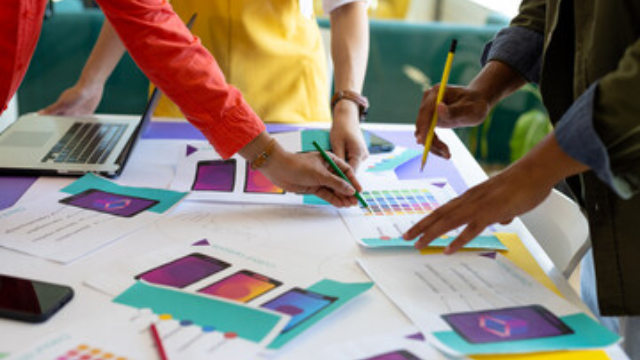Do you ever wonder how graphic designers create powerful designs that capture your attention and evoke specific emotions? In the world of graphic design, psychology plays a crucial role. By understanding how the human mind perceives and responds to visual elements, designers can strategically use colors, shapes, and typography to convey messages and create meaningful experiences. In this article, we will explore the fascinating ways in which psychology is applied in graphic design to captivate and engage audiences.
Understanding Color Psychology
To understand color psychology in graphic design, you need to recognize the powerful impact colors have on human emotions and perceptions. Color symbolism plays a significant role in how people interpret and respond to visual stimuli. Different colors evoke different emotions and can convey specific messages. For example, red is often associated with passion, energy, and urgency, while blue is linked to calmness, trust, and reliability. Understanding these color associations allows graphic designers to strategically use colors to elicit specific emotional responses from viewers.
In addition to color symbolism, the psychology of shapes also influences how people perceive and interpret visual designs. Different shapes can convey different meanings and evoke specific responses. For instance, circles are often associated with unity, harmony, and completeness, while squares and rectangles represent stability, balance, and reliability. By understanding the psychological impact of shapes, graphic designers can effectively communicate messages and evoke desired emotions through the use of different shapes in their designs.
Utilizing Gestalt Principles
Now, let’s delve into how you can utilize Gestalt principles in your graphic design to enhance visual communication and create a cohesive and impactful design. Gestalt psychology focuses on how our minds perceive and organize visual elements. By applying visual perception principles, you can create designs that are visually appealing and easy to comprehend.
One key principle is the Law of Closure, which suggests that our brains tend to fill in missing information to create a complete image. By using this principle, you can create designs that encourage viewers to mentally complete the missing parts, leading to a more engaging and memorable experience.
Another important principle is the Law of Proximity, which states that objects that are close to each other are perceived as being related. By grouping related elements together, you can guide the viewer’s attention and create a sense of unity in your design.
The Law of Similarity tells us that elements that share similar characteristics, such as shape or color, are perceived as belonging to the same group. By using this principle, you can create visual hierarchy and emphasize important elements in your design.
Lastly, the Law of Continuity suggests that our minds tend to perceive continuous lines or curves as a single entity. By utilizing this principle, you can create smooth and flowing designs that guide the viewer’s eye through the composition.
Applying Typography Techniques
How can you effectively apply typography techniques in graphic design? Typography plays a crucial role in graphic design, as it not only conveys information but also has a psychological appeal that can greatly impact the viewer’s perception and understanding of a design. By understanding and utilizing typography trends, you can create designs that effectively communicate your message and evoke the desired emotional response. Here are four important typography techniques to consider:
- Font Choice: Selecting the right font can set the tone and convey the personality of your design. Serif fonts, for example, can create a sense of tradition and elegance, while sans-serif fonts can give a more modern and clean look.
- Hierarchy: Establishing a clear hierarchy within your typography helps guide the viewer’s attention and prioritizes information. Differentiating font sizes, weights, and styles can help create a visual hierarchy that makes it easier for the viewer to navigate the design.
- Alignment: Proper alignment can create a sense of order and harmony in your design. Whether it’s left-aligned, centered, or justified, the alignment of your typography can influence how the viewer perceives and interacts with the design.
- Readability: Ensuring that your typography is legible and readable is crucial. Consider factors such as spacing, line length, and contrast to optimize readability and enhance the viewer’s overall experience.
Incorporating Visual Hierarchy
When it comes to graphic design, incorporating visual hierarchy is essential. Visual hierarchy refers to the arrangement and organization of visual elements in a design to guide the viewer’s attention and establish a clear order of importance. By strategically using size, color, contrast, and placement, designers can create a hierarchy that not only enhances the overall aesthetics but also has a psychological impact on the viewer, influencing their perception and understanding of the design’s message.
Importance of Visual Hierarchy
Understand the importance of incorporating visual hierarchy in graphic design. Visual hierarchy refers to the arrangement and organization of elements in a design to guide the viewer’s attention and create a clear and effective communication. By utilizing visual hierarchy, you can effectively convey your message and enhance the overall user experience. Here are four reasons why visual hierarchy is crucial in graphic design:
- Understanding Visual Perception: Visual hierarchy takes into account how the human eye perceives and processes information. By arranging elements in a logical and hierarchical order, you can ensure that the viewer’s attention is directed to the most important information first.
- Guiding the Viewer: Visual hierarchy helps guide the viewer’s eye through the design, leading them to important elements and creating a clear flow of information.
- Emphasizing Key Information: By utilizing visual hierarchy, you can highlight important information or key messages, making them stand out and grab the viewer’s attention.
- Psychological Impact of Color Choice: Visual hierarchy also considers the psychological impact of color choice. Certain colors can evoke specific emotions and reactions, and by strategically using colors with different levels of intensity, you can create a hierarchy of importance within your design.
Psychological Impact of Hierarchy
To incorporate visual hierarchy effectively in graphic design, you need to consider the psychological impact of hierarchy. Cognitive biases in design and the psychological influence on decision making play a significant role in how viewers perceive and interact with visual elements. Understanding these psychological factors can help designers create more engaging and impactful designs.
One cognitive bias that designers can leverage is known as the “primacy effect.” This bias suggests that people tend to remember and prioritize information that they encounter first. By placing important elements at the top or beginning of a design, designers can take advantage of this bias and ensure that crucial information is seen and remembered by viewers.
Another cognitive bias to consider is the “recency effect,” which states that people also tend to remember information that they encounter last. Designers can use this bias by placing important elements at the end of a design, ensuring that they leave a lasting impression on viewers.
Additionally, the “Gestalt principles” of perception can help designers create effective visual hierarchies. These principles, such as proximity, similarity, and closure, explain how viewers naturally group and organize visual elements. By understanding these principles, designers can arrange elements in a way that guides viewers’ attention and aids comprehension.
Designing for Emotional Impact
To create a powerful emotional impact in graphic design, you can employ psychological principles. By understanding how color symbolism and the psychology of shapes influence emotions, you can effectively design visuals that evoke specific feelings in your audience. Here are four ways you can design for emotional impact:
- Color symbolism: Different colors have distinct psychological associations. For example, warm colors like red and orange can evoke feelings of passion and energy, while cool colors like blue and green can create a sense of calmness and tranquility. By strategically using colors in your design, you can elicit specific emotional responses from your viewers.
- Shapes and emotions: The psychology of shapes suggests that certain shapes can trigger specific emotions. For instance, sharp angles and jagged lines can create a sense of tension or unease, while curved lines and organic shapes can evoke feelings of comfort and relaxation. By incorporating shapes that align with the desired emotional response, you can enhance the impact of your design.
- Typography and mood: The choice of typography can greatly impact the emotional tone of your design. Bold and thick fonts can convey strength and power, while delicate and flowing fonts can evoke elegance and grace. Paying attention to the typography in your design can help you effectively communicate the intended emotional message.
- Visual hierarchy: The arrangement of elements in your design can influence the emotional impact it has on viewers. By using size, color, and placement, you can guide the viewer’s eye and create a visual hierarchy that directs attention and elicits emotional responses. Understanding how to manipulate visual hierarchy can enhance the emotional impact of your design.
Creating User-Friendly Interfaces
When it comes to creating user-friendly interfaces, understanding cognitive load and its impact on user experience (UX) is crucial. By designing interfaces that minimize cognitive load, such as simplifying navigation and reducing visual clutter, you can enhance usability and make it easier for users to navigate your website or application. Additionally, employing color psychology and perception can further optimize user interfaces by leveraging the emotional and psychological associations that different colors evoke. Lastly, incorporating emotional design principles, such as using visuals and microinteractions to create a sense of delight or anticipation, can help engage users on a deeper level and foster positive user experiences.
Cognitive Load and UX
Reduce cognitive load to enhance user experience by simplifying interface design. When it comes to user experience and cognitive load, graphic designers play a crucial role in creating interfaces that are easy to understand and navigate. By understanding how the human brain processes information, designers can optimize the user experience by reducing cognitive load. Here are four ways in which cognitive load can be minimized in interface design:
- Simplify the layout: Avoid clutter and unnecessary elements that can overwhelm users and distract them from the main tasks.
- Use clear and concise language: Communicate information in a straightforward manner to avoid confusion and cognitive overload.
- Provide visual hierarchy: Use visual cues such as size, color, and spacing to guide users’ attention to the most important elements.
- Minimize cognitive switching: Reduce the need for users to switch between different tasks or modes, as it can increase cognitive load and decrease efficiency.
Color Psychology and Perception
Create user-friendly interfaces by understanding how color psychology and perception can impact the user experience. Color symbolism plays a significant role in how users interpret and interact with digital interfaces. Different colors evoke different emotions and associations, which can influence users’ perception of a website or application. For example, warm colors like red and orange are often associated with energy and excitement, while cool colors like blue and green are linked to calmness and trustworthiness. Additionally, visual perception plays a crucial role in how users navigate and understand a design. By strategically using color contrast, designers can enhance legibility and draw attention to important elements. Understanding the psychology behind color and leveraging visual perception can help designers create interfaces that are not only visually appealing but also intuitive and user-friendly.
Emotional Design Principles
To enhance user experience, designers can implement emotional design principles in their interfaces, utilizing the psychology behind human emotions and creating a more user-friendly experience. Emotional branding and user experience psychology play a crucial role in creating interfaces that resonate with users on a deeper level. Here are four key principles to consider:
- Understand your target audience: Conduct research to gain insights into the emotions, needs, and motivations of your users. This will help you design interfaces that cater to their specific emotions and preferences.
- Use color psychology: Colors evoke different emotions and can greatly impact user experience. Choose colors that align with the emotions you want to evoke and ensure they are consistent throughout the interface.
- Incorporate storytelling: Storytelling can create an emotional connection between users and the interface. Use narratives, visuals, and interactive elements to engage users and evoke specific emotions.
- Design for usability and aesthetics: Emotional design is not just about creating visually appealing interfaces. It should also focus on usability, ensuring that users can easily navigate and interact with the interface while experiencing positive emotions.



